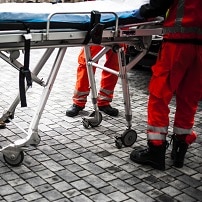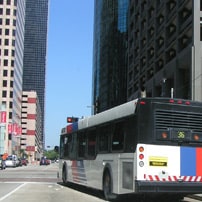While some people dread the end of the summer, others simply love the fall. The change of season brings cooler weather and cherished traditions. A drive to see fall foliage is a ritual many people enjoy. A lot of autumn activities involve driving. You should be prepared for fall-related driving issues ahead of time in order to avoid a car accident in autumn.
Prepare for Reduced Visibility
Fall in the Northeastern United States involves shorter days. Trips that were previously in full daylight in the summer may now be in the dark. You may find your commute involves driving into the glare of a setting sun, which can greatly impair your vision. Consider wearing glasses with an anti-reflective (AR) coating on the lenses to reduce glare and improve vision.
The ability to drive at night changes with age. If you notice halo effects or increased glare from lights while driving at dusk or at night, you may need prescription eyeglasses. If so, be sure to have your eyes checked, and wear eyeglasses or contact lenses to correct vision.
Visibility can be very limited in conditions of heavy rain, fog, or water spray, which are all common during the fall. Be sure windshield wipers are not worn out, and the windshield washer fluid reservoir is full. Wiper blades that make a scratching sound when operated, appear cracked or distorted, or leave streaks need to be replaced. Replace blades regularly or as soon as they show signs of wear.
Fog can decrease visibility greatly, and slowing down and increasing following distance are both important precautions to take in foggy conditions. When driving in foggy conditions, it is best to use low beams since high beams reflect off the fog.
Avoid Piles of Fallen Leaves
Fallen leaves can pose some unique hazards. They are slippery, and driving on them makes it harder to stop quickly. They can also conceal potholes and other roadway deficiencies. Unfortunately, accidents have happened where children playing in piles of leaves have been injured or killed when drivers attempted to park on the leaves and were unable to see the children playing.
Be Mindful of Students and School Buses
Children have returned to school, and school buses will be dropping off and picking up students. Remember to stop in both directions when a school bus is loading or unloading students. Be careful to wait before proceeding as children may need to cross the street once they exit the bus.
Expect Poor Weather
Fall weather includes a lot of rain, which poses a series of difficult driving conditions. Rain can cause problems when it first starts because the water combines with oil on the road to create a very slippery film. This increases the risk of hydroplaning, which is when the tread fails to channel water away from the tire and the tires lose contact with the road. Poor tire tread increases the risk of hydroplaning.
Heavy rain can also cause flash floods. If you must drive during heavy rains, be sure to check local news reporting on roadway conditions. Heed local flash flood warnings and barriers. Do not drive into puddles when the depth cannot be determined. Driving in water deeper than about 6 inches will likely cause the vehicle to stall. Driving a vehicle in 12 inches or more of water will risk it floating away.
Be Careful of Deer
Fall is deer mating season, and they are most active during dawn and dusk. It is especially important to practice the “three-second plus rule” to allow enough time to maneuver safely around unexpected obstacles. Ordinarily, it is advised you maintain three seconds worth of distance from the vehicle in front of you. Once the vehicle in front passes a stationary object, you should be able to count for three seconds before passing the object.
The “plus” part of the rule suggests adding one second of distance for each situation where conditions may require additional time to react. For example, when driving in the rain during deer mating season, allow five seconds worth of distance from the vehicle in front of you. The added distance provides more time to react and avoid a collision.
Vehicle Maintenance
Be sure your vehicle is up to the task before taking to the road to enjoy fall activities. Tires are important for safe operation of every vehicle. Both tire tread and tire pressure need to be kept within safe limits.
Adequate tire treads protect against losing traction. The rate of wear depends on driving conditions. Tire ratings are a poor measure of how long tires will last. Check tire tread with a penny by inserting it into the tread and touching the tire with the top of Lincoln’s head pointed toward the tire. If it is possible to see the top of his head, then there is not enough tread. Be sure tires have enough tread in advance of the fall season.
Underinflated or overinflated tires increase wear and tear and can be more prone to blowouts. Fill tires when they are cold to the proper pressure as indicated in the tire and loading information label on the inside of the driver’s side door jam or in the owner’s manual. Many gas stations have air pumps with built in tire pressure gauges for this purpose.
The following are additional routine inspection and maintenance tasks to tackle before taking any long trips in the fall. Oil must be changed regularly for safe operation. Follow manufacturer’s recommendations for changing oil.
Check the condition of brake pads and rotors regularly. It will save money in the long run to replace worn brake pads before damage to the rotors occurs.
Finally, check the engine coolant level and condition. The coolant keeps the engine cool, lubricates the moving parts, and protects the rubber seals from cracking. Change the coolant as per manufacturer’s instructions or the advice of a trusted mechanic.
Plan Out the Route
If you will be taking an excursion to see the fall foliage or visit relatives, be sure to first follow the above maintenance trips. Next, be sure to know where you are going. Cellphones now have apps that provide directions, including information on points of interest, such as lodging, gas stations, restaurants, and the like. Some apps provide warnings of traffic delays and offer alternate routes to avoid accidents.
Make sure the cellphone is charged, that there is a charger in the vehicle, and you position the cellphone so it can be used hands free. Additionally, have drinking water, snacks, warm clothes, and a first-aid kit for added comfort and security.
Wilmington Car Accident Lawyers at Rhoades & Morrow Help Drivers Injured in Severe Autumn-Related Accidents
Autumn presents unique driving hazards, and you should prepare for the weather change ahead of time. If you become injured in a fall-related accident, speak with one of our Wilmington car accident lawyers at Rhoades & Morrow. Complete our online form or call us at (302) 427-9500 to schedule a free consultation. Located in Wilmington, Bear, and Milford, Delaware, we serve clients throughout Middletown, Dover, Milford, Lewes, Rehoboth, Elsmere, and Seaford.





